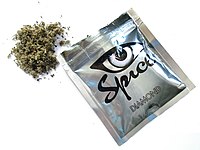
Photo from wikipedia
Three synthetic carboxamide-type cannabinoids (5F-MDMB-PICA, 5F-EMB-PINACA, and AMB-CHMICA) were evaluated in terms of their in vitro activities at the cannabinoid receptors CB1 and CB2 and in vivo biological effects when… Click to show full abstract
Three synthetic carboxamide-type cannabinoids (5F-MDMB-PICA, 5F-EMB-PINACA, and AMB-CHMICA) were evaluated in terms of their in vitro activities at the cannabinoid receptors CB1 and CB2 and in vivo biological effects when smoking the synthetic cannabinoids to assess their biological effects. [35S]Guanosine-5′-O-(3-thio)-triphosphate binding assays were performed to investigate the half maximal effective concentration values of the test compounds at the CB1 and CB2 receptors. Additionally, the biological effects were evaluated by observing and scoring the behavior of mice with equipment in which they inhaled smoke from a herbal mixture containing the test compounds. All three synthetic cannabinoids tested in this study activated the CB1 and CB2 receptors in vitro. 5F-MDMB-PICA showed less than 1 nM of the half maximal effective concentration value for both receptors. Therefore, it was suggested that 5F-MDMB-PICA was the strongest CB1 and CB2 receptor agonist in comparison with synthetic cannabinoids evaluated in the past. The degree of the various biological effects, specifically passivity, spontaneous activity, abnormal gait, abnormal position, and grip strength, when smoking the synthetic cannabinoids corresponded to the functional activity at the CB1 receptor. However, some biological effects differed between 5F-MDMB-PICA and 5F-MDMB-PINACA, used as a positive control, and AMB-CHMICA induced some biological effects in contrast to the other tested synthetic cannabinoids. This study provides information regarding the biological effects when smoking synthetic cannabinoids from the functional activities at the CB1 and CB2 receptors, considering their way of inhalation and thermal degradation.
Journal Title: Forensic Toxicology
Year Published: 2020
Link to full text (if available)
Share on Social Media: Sign Up to like & get
recommendations!